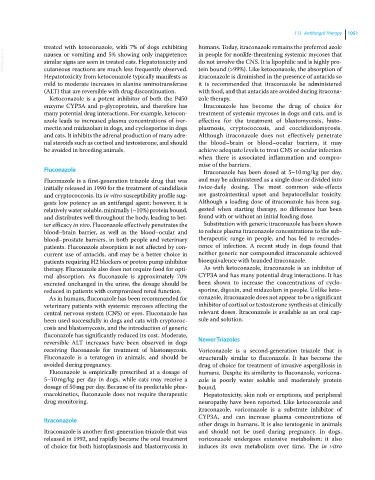Page 1113 - Clinical Small Animal Internal Medicine
P. 1113
115 Antifungal Therapy 1051
treated with ketoconazole, with 7% of dogs exhibiting humans. Today, itraconazole remains the preferred azole
VetBooks.ir nausea or vomiting and 5% showing only inappetence; in people for nonlife‐threatening systemic mycoses that
do not involve the CNS. It is lipophilic and is highly pro
similar signs are seen in treated cats. Hepatotoxicity and
cutaneous reactions are much less frequently observed.
itraconazole is diminished in the presence of antacids so
Hepatotoxicity from ketoconazole typically manifests as tein bound (>99%). Like ketoconazole, the absorption of
mild to moderate increases in alanine aminotransferase it is recommended that itraconazole be administered
(ALT) that are reversible with drug discontinuation. with food, and that antacids are avoided during itracona
Ketoconazole is a potent inhibitor of both the P450 zole therapy.
enzyme CYP3A and p‐glycoprotein, and therefore has Itraconazole has become the drug of choice for
many potential drug interactions. For example, ketocon treatment of systemic mycoses in dogs and cats, and is
azole leads to increased plasma concentrations of iver effective for the treatment of blastomycosis, histo
mectin and midazolam in dogs, and cyclosporine in dogs plasmosis, cryptococcosis, and coccidioidomycosis.
and cats. It inhibits the adrenal production of many adre Although itraconazole does not effectively penetrate
nal steroids such as cortisol and testosterone, and should the blood–brain or blood–ocular barriers, it may
be avoided in breeding animals. achieve adequate levels to treat CNS or ocular infection
when there is associated inflammation and compro
mise of the barriers.
Fluconazole Itraconazole has been dosed at 5–10 mg/kg per day,
Fluconazole is a first‐generation triazole drug that was and may be administered as a single dose or divided into
initially released in 1990 for the treatment of candidiasis twice‐daily dosing. The most common side‐effects
and cryptococcosis. Its in vitro susceptibility profile sug are gastrointestinal upset and hepatocellular toxicity.
gests low potency as an antifungal agent; however, it is Although a loading dose of itraconazole has been sug
relatively water soluble, minimally (~10%) protein bound, gested when starting therapy, no difference has been
and distributes well throughout the body, leading to bet found with or without an initial loading dose.
ter efficacy in vivo. Fluconazole effectively penetrates the Substitution with generic itraconazole has been shown
blood–brain barrier, as well as the blood–ocular and to reduce plasma itraconazole concentrations to the sub
blood–prostate barriers, in both people and veterinary therapeutic range in people, and has led to recrudes
patients. Fluconazole absorption is not affected by con cence of infection. A recent study in dogs found that
current use of antacids, and may be a better choice in neither generic nor compounded itraconazole achieved
patients requiring H2 blockers or proton pump inhibitor bioequivalence with branded itraconazole.
therapy. Fluconazole also does not require food for opti As with ketoconazole, itraconazole is an inhibitor of
mal absorption. As fluconazole is approximately 70% CYP3A and has many potential drug interactions. It has
excreted unchanged in the urine, the dosage should be been shown to increase the concentrations of cyclo
reduced in patients with compromised renal function. sporine, digoxin, and midazolam in people. Unlike keto
As in humans, fluconazole has been recommended for conazole, itraconazole does not appear to be a significant
veterinary patients with systemic mycoses affecting the inhibitor of cortisol or testosterone synthesis at clinically
central nervous system (CNS) or eyes. Fluconazole has relevant doses. Itraconazole is available as an oral cap
been used successfully in dogs and cats with cryptococ sule and solution.
cosis and blastomycosis, and the introduction of generic
fluconazole has significantly reduced its cost. Moderate,
reversible ALT increases have been observed in dogs Newer Triazoles
receiving fluconazole for treatment of blastomycosis. Voriconazole is a second‐generation triazole that is
Fluconazole is a teratogen in animals, and should be structurally similar to fluconazole. It has become the
avoided during pregnancy. drug of choice for treatment of invasive aspergillosis in
Fluconazole is empirically prescribed at a dosage of humans. Despite its similarity to fluconazole, voricona
5–10 mg/kg per day in dogs, while cats may receive a zole is poorly water soluble and moderately protein
dosage of 50 mg per day. Because of its predictable phar bound.
macokinetics, fluconazole does not require therapeutic Hepatotoxicity, skin rash or eruptions, and peripheral
drug monitoring. neuropathy have been reported. Like ketoconazole and
itraconazole, voriconazole is a substrate inhibitor of
CYP3A, and can increase plasma concentrations of
Itraconazole
other drugs in humans. It is also teratogenic in animals
Itraconazole is another first‐generation triazole that was and should not be used during pregnancy. In dogs,
released in 1992, and rapidly became the oral treatment voriconazole undergoes extensive metabolism; it also
of choice for both histoplasmosis and blastomycosis in induces its own metabolism over time. The in vitro

